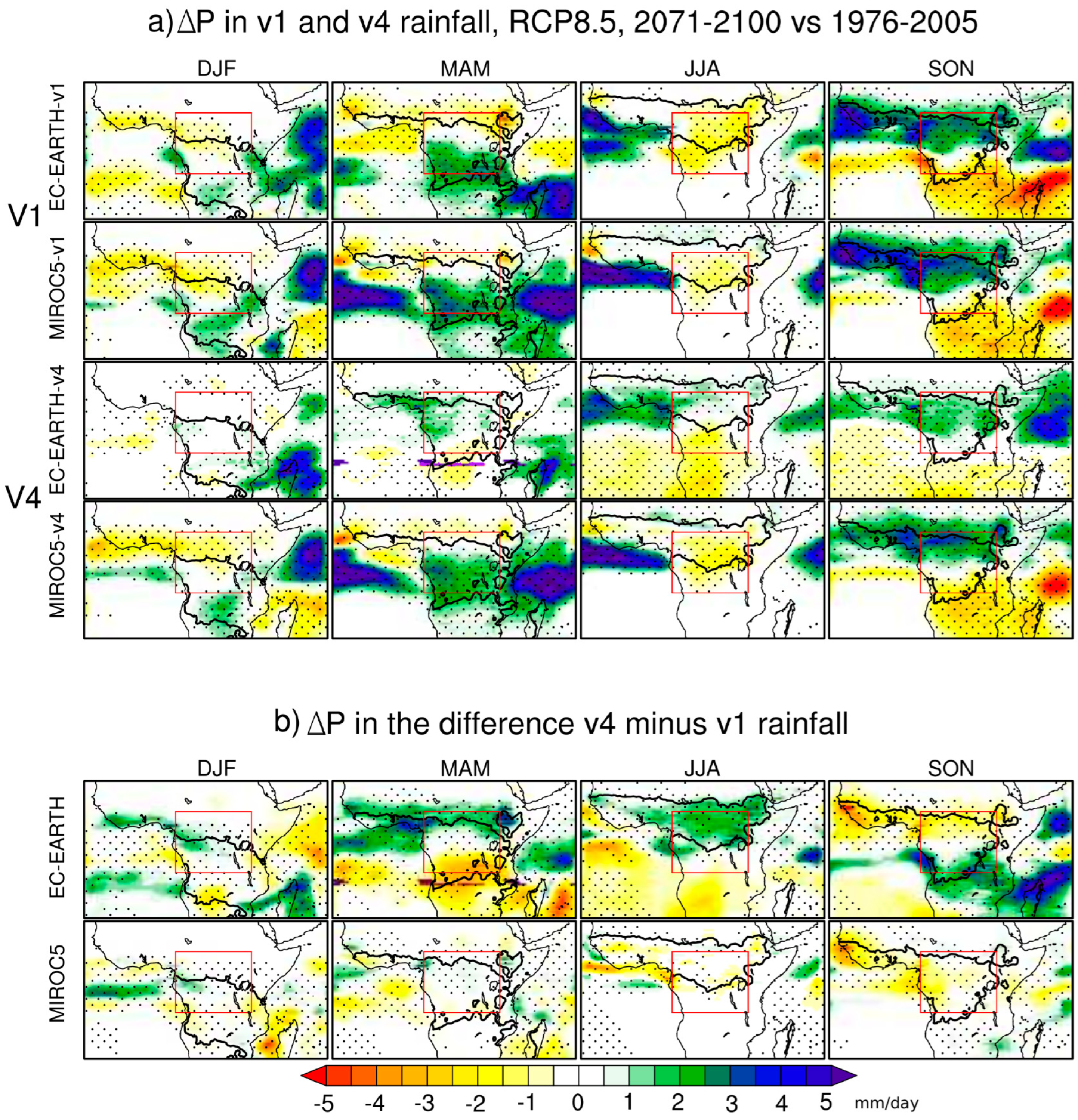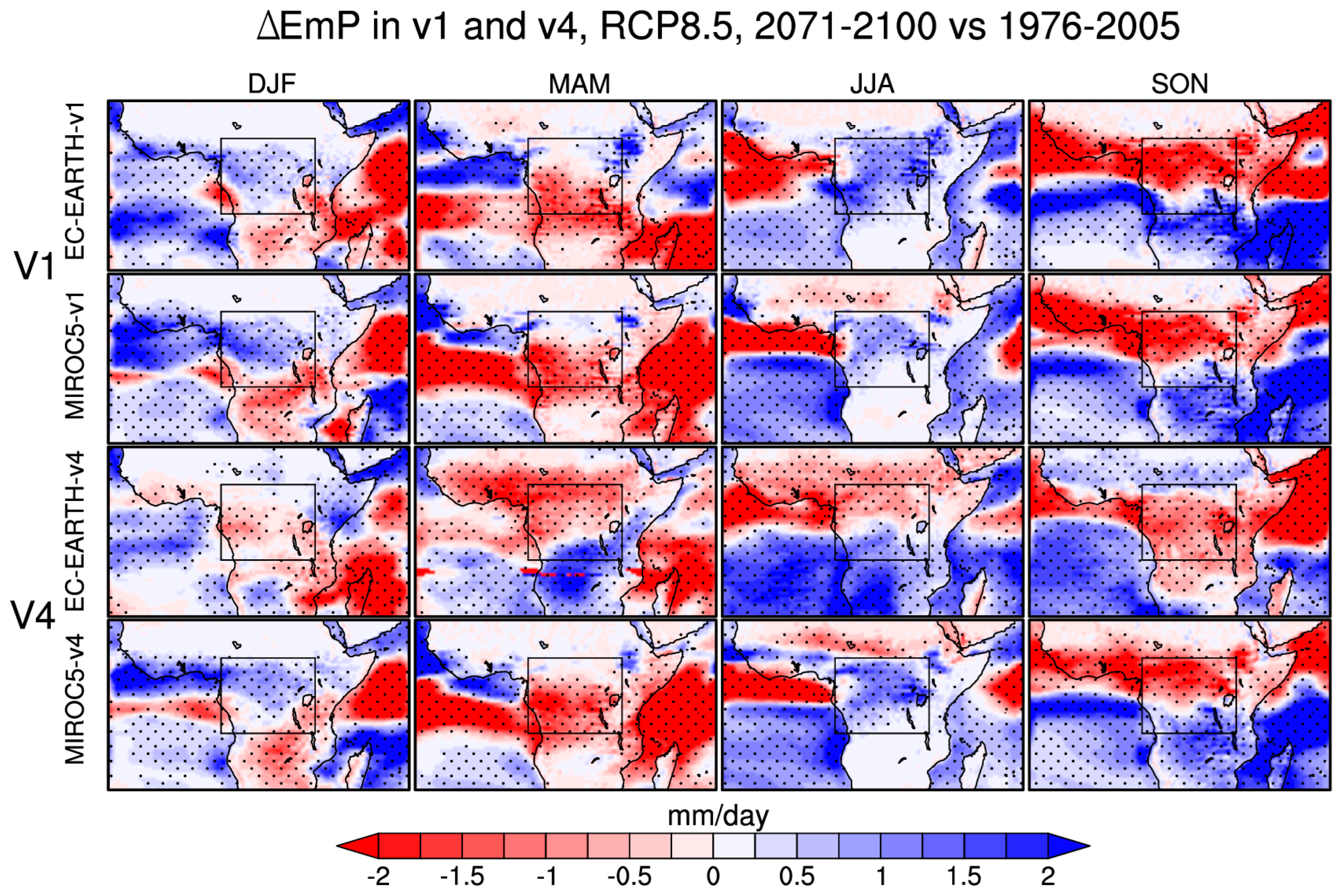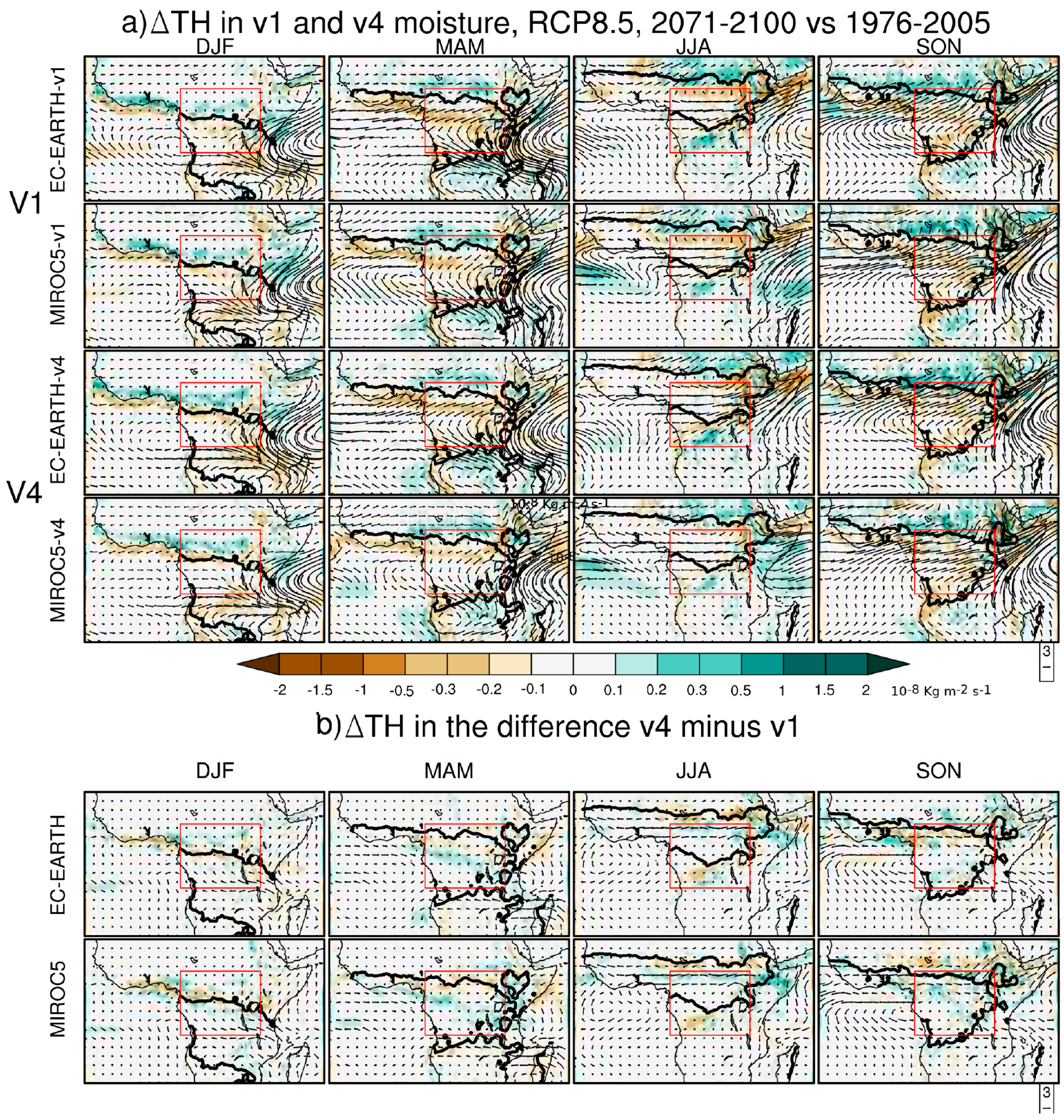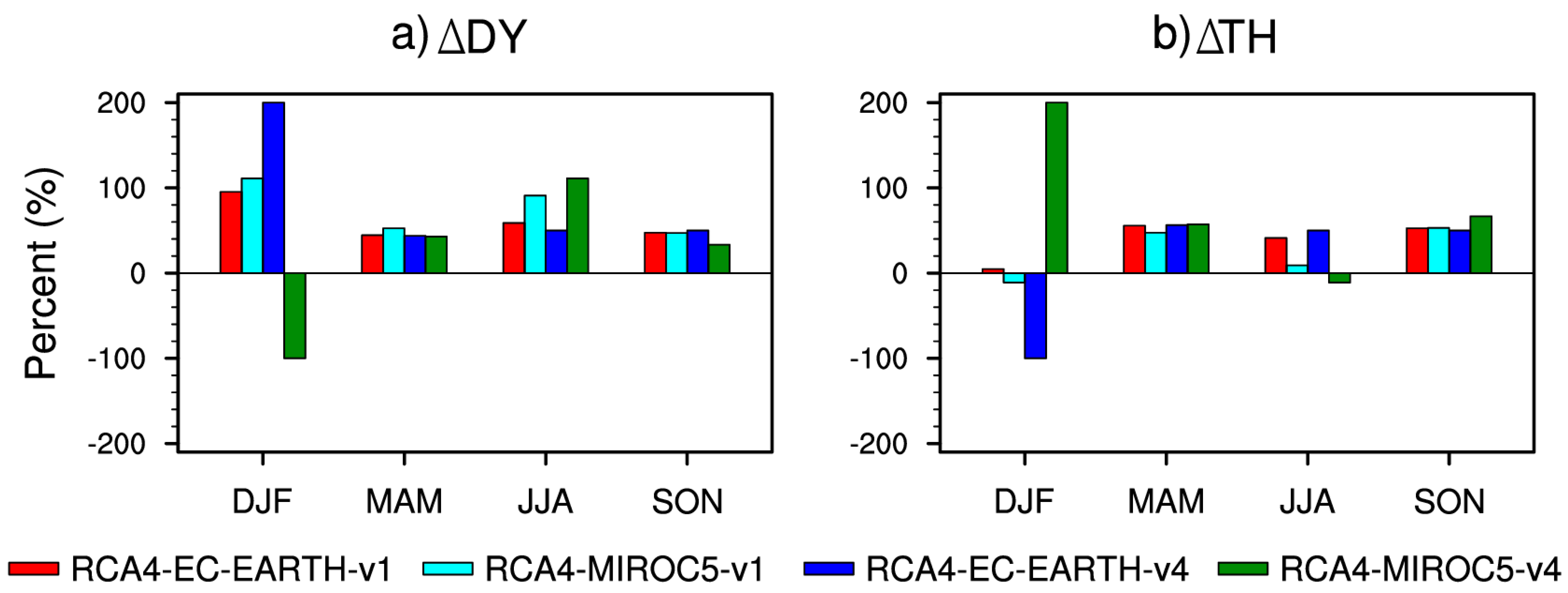Dynamic and Thermodynamic Contributions to Late 21st Century Projected Rainfall Change in the Congo Basin: Impact of a Regional Climate Model’s Formulation
Abstract
:1. Introduction
2. Model Data and Methods
3. Results
3.1. Precipitation Changes
3.2. Potential Mechanisms for Precipitation Changes
3.2.1. Moisture Convergence Changes
3.2.2. Dynamic and Thermodynamic Contributions to Moisture Changes
4. Impacts of the Model Formulation on the Simulated Future Climate
5. Summary and Discussion
Author Contributions
Funding
Institutional Review Board Statement
Informed Consent Statement
Data Availability Statement
Acknowledgments
Conflicts of Interest
References
- Sørland, S.L.; Schär, C.; Luethi, D.; Kjellström, E. Bias patterns and climate change signals in GCM-RCM model chains. Environ. Res. Lett. 2018, 13, 074017. [Google Scholar] [CrossRef]
- Wu, M.; Nikulin, G.; Kjellström, E.; Belušić, D.; Jones, C.; Lindstedt, D. The impact of regional climate model formulation and resolution on simulated precipitation in Africa. Earth Syst. Dyn. 2020, 11, 377–394. [Google Scholar] [CrossRef]
- Somot, S.; Sevault, F.; Déqué, M.; Crépon, M. 21st century climate change scenario for the Mediterranean using a coupled atmosphere–ocean regional climate model. Glob. Planet. Change 2008, 63, 112–126. [Google Scholar] [CrossRef]
- Sein, D.V.; Mikolajewicz, U.; Gröger, M.; Fast, I.; Cabos, W.; Pinto, J.G.; Hagemann, S.; Semmler, T.; Izquierdo, A.; Jacob, D. Regionally coupled atmosphere-ocean-sea ice-marine biogeochemistry model ROM: Description and validation. J. Adv. Model. Earth Syst. 2015, 7, 268–304. [Google Scholar] [CrossRef]
- Zou, L.; Zhou, T. A regional ocean–atmosphere coupled model developed for CORDEX East Asia: Assessment of Asian summer monsoon simulation. Clim. Dyn. 2016, 47, 3627–3640. [Google Scholar] [CrossRef]
- Zou, L.; Zhou, T. Future summer precipitation changes over CORDEX-East Asia domain downscaled by a regional ocean-atmosphere coupled model: A comparison to the stand-alone RCM. J. Geophys. Res. Atmos. 2017, 121, 2691–2704. [Google Scholar] [CrossRef]
- Boé, J.; Somot, S.; Corre, L.; Nabat, P. Large discrepancies in summer climate change over Europe as projected by global and regional climate models: Causes and consequences. Clim. Dyn. 2020, 54, 2981–3002. [Google Scholar] [CrossRef]
- Gutiérrez, C.; Somot, S.; Nabat, P.; Mallet, M.; Corre, L.; van Meijgaard, E.; Perpiñán, O.; Gaertner, M. Future evolution of surface solar radiation and photovoltaic potential in Europe: Investigating the role of aerosols. Environ. Res. Lett. 2020, 15, 034035. [Google Scholar] [CrossRef]
- Schwingshackl, C.; Davin, E.L.; Hirschi, M.; Sørland, S.L.; Wartenburger, R.; I Seneviratne, S. Regional climate model projections underestimate future warming due to missing plant physiological CO2 response. Environ. Res. Lett. 2019, 14, 114019. [Google Scholar] [CrossRef]
- Xie, B.; Fung, J.C.H. A comparison of momentum mixing models for the planetary boundary layer. J. Geophys. Res. Atmos. 2014, 119, 2079–2091. [Google Scholar] [CrossRef]
- Doblas-Reyes, F.J.; Sörensson, A.A.; Almazroui, M.; Dosio, A.; Gutowski, W.J.; Haarsma, R.; Hamdi, R.; Hewitson, B.; Kwon, W.-T.; Lamptey, B.L.; et al. Linking Global to Regional Climate Change. In Climate Change 2021: The Physical Science Basis; Contribution of Working Group I to the Sixth Assessment Report of the Intergovernmental Panel on Climate Change; Intergovernmental Panel on Climate Change: Geneva, Switzerland, 2021. [Google Scholar] [CrossRef]
- Rowell, D.P.; Senior, C.A.; Vellinga, M.; Graham, R.J. Can climate projection uncertainty be constrained over Africa using metrics of contemporary performance? Clim. Change 2015, 134, 621–633. [Google Scholar] [CrossRef]
- James, R.; Washington, R.; Abiodun, B.; Kay, G.; Mutemi, J.; Pokam, W.; Hart, N.; Artan, G.; Senior, C. Evaluating Climate Models with an African Lens. Bull. Am. Meteorol. Soc. 2018, 99, 313–336. [Google Scholar] [CrossRef]
- Creese, A.; Washington, R.; Jones, R. Climate change in the Congo Basin: Processes related to wetting in the December–February dry season. Clim. Dyn. 2019, 53, 3583–3602. [Google Scholar] [CrossRef]
- Creese, A.; Washington, R.; Munday, C. The Plausibility of September–November Congo Basin Rainfall Change in Coupled Climate Models. J. Geophys. Res. Atmos. 2019, 124, 5822–5846. [Google Scholar] [CrossRef]
- Tamoffo, A.T.; Moufouma-Okia, W.; Dosio, A.; James, R.; Pokam, W.M.; Vondou, D.A.; Fotso-Nguemo, T.C.; Guenang, G.M.; Kamsu-Tamo, P.H.; Nikulin, G.; et al. Process-oriented assessment of RCA4 regional climate model projections over the Congo Basin under 1.5 °C and 2 °C global warming levels: Influence of regional moisture fluxes. Clim. Dyn. 2019, 53, 1911–1935. [Google Scholar] [CrossRef]
- Tamoffo, A.T.; Nikulin, G.; Vondou, D.A.; Dosio, A.; Nouayou, R.; Wu, M.; Igri, P.M. Process-based assessment of the impact of reduced turbulent mixing on Congo Basin precipitation in the RCA4 Regional Climate Model. Clim. Dyn. 2021, 56, 1951–1965. [Google Scholar] [CrossRef]
- Taylor, K.E.; Stouffer, R.J.; Meehl, G.A. An overview of CMIP5 and the experiment design. Bull. Amer. Meteor. Soc. 2012, 93, 485–498. [Google Scholar] [CrossRef]
- Taylor, K.E.; Stouffer, R.J.; Meehl, G.A. On the range of future Sahel precipitation projections and the selection of a sub-sample of CMIP5 models for impact studies. Clim. Dyn. 2016, 48, 2751–2770. [Google Scholar] [CrossRef]
- Dosio, A.; Turner, A.G.; Tamoffo, A.T.; Sylla, M.B.; Lennard, C.; Jones, R.G.; Terray, L.; Nikulin, G.; Hewitson, B. A tale of two futures: Contrasting scenarios of future precipitation for West Africa from an ensemble of Regional Climate Models. Environ. Res. Lett. 2020, 15, 064007. [Google Scholar] [CrossRef]
- Pokam, W.M.; Bain, C.L.; Chadwick, R.S.; Graham, R.; Sonwa, D.J.; Kamga, F.M. Identification of processes driving low-level westerlies in west equatorial Africa. J. Clim. 2014, 27, 4245–4262. [Google Scholar] [CrossRef]
- Creese, A.; Washington, R. Using qflux to constrain modeled Congo Basin rainfall in the CMIP5 ensemble. J. Geophys. Res. Atmos. 2016, 121, 13415–13442. [Google Scholar] [CrossRef]
- Dyer, E.L.; Jones, D.B.; Nusbaumer, J.; Li, H.; Collins, O.; Vettoretti, G.; Noone, D. Congo basin precipitation: Assessing seasonality, regional interactions, and sources of moisture. J. Geophys. Res. Atmos. 2017, 122, 6882–6898. [Google Scholar] [CrossRef]
- Washington, R.; James, R.; Pearce, H.; Pokam, W.M.; Moufouma-Okia, W. Congo basin rainfall climatology: Can we believe the climate models? Philos. Trans. R. Soc. Lond. B Biol. Sci. 2013, 368, 20120296. [Google Scholar] [CrossRef] [PubMed]
- Van der Ent, R.J.; Savenije, H.H.; Schaefli, B.; Steele-Dunne, S.C. Origin and fate of atmospheric moisture over continents. Water Resour. Res. 2010, 46. [Google Scholar] [CrossRef]
- Van der Ent, R.J.; Savenije, H.H.G. Oceanic sources of continental precipitation and the correlation with sea surface temperature. Water Resour. Res. 2013, 49, 3993–4004. [Google Scholar] [CrossRef]
- Pokam, W.M.; Djiotang, L.A.T.; Mkankam, F.K. Atmospheric water vapor transport and recycling in equatorial central africa through ncep/ncar reanalysis data. Clim. Dyn. 2012, 38, 1715–1729. [Google Scholar] [CrossRef]
- Munday, C.; Washington, R.; Hart, N. African Low-Level Jets and Their Importance for Water Vapor Transport and Rainfall. Geophys. Res. Lett. 2021, 48, e2020GL090999. [Google Scholar] [CrossRef]
- Lee, D.; Min, S.-K.; Jin, J.; Lee, J.-W.; Cha, D.-H.; Suh, M.-S.; Ahn, J.-B.; Hong, S.-Y.; Kang, H.-S.; Joh, M. Thermodynamic and dynamic contributions to future changes in summer precipitation over Northeast Asia and Korea: A multi-RCM study. Clim. Dyn. 2017, 49, 4121–4139. [Google Scholar] [CrossRef]
- Longandjo, G.-N.T.; Rouault, M. On the structure of the regional-scale circulation over central africa: Seasonal evolution, variability, and mechanisms. J. Clim. 2020, 33, 145–162. [Google Scholar] [CrossRef]
- Strandberg, G.; Bärring, L.; Hansson, U.; Jansson, C.; Jones, C.; Kjellström, E.; Kupiainen, M.; Nikulin, G.; Samuelsson, P.; Ullerstig, A. CORDEX Scenarios for Europe from the Rossby Centre Regional Climate Model; RCATechnical Report 116; Climate Research-Rossby Centre: Norrköping, Sweden, 2015. [Google Scholar]
- Giorgi, F.; Jones, C.; Asrar, G.R. Addressing climate information needs at the regional level: The CORDEX framework. WMO Bull. 2009, 58, 175–183. Available online: https://public.wmo.int/en/bulletin/addressing-climate-information-needs-regional-level-cordex-framework (accessed on 11 September 2023).
- Van Vuuren, D.P.; Edmonds, J.; Kainuma, M.; Riahi, K.; Thomson, A.; Hibbard, K.; Hurtt, G.C.; Kram, T.; Krey, V.; Lamarque, J.-F.; et al. The representative concentration pathways: An overview. Clim. Change 2011, 109, 5. [Google Scholar] [CrossRef]
- Dosio, A.; Lennard, C.; Spinoni, J. Projections of indices of daily temperature and precipitation based on bias-adjusted CORDEX-Africa regional climate model simulations. Clim. Change 2022, 170, 13. [Google Scholar] [CrossRef]
- Wu, M.; Schurgers, G.; Rummukainen, M.; Smith, B.; Samuelsson, P.; Jansson, C.; Siltberg, J.; May, W. Vegetation–climate feedback modulates rainfall patterns in Africa under future climate change. Earth Syst. Dyn. 2016, 7, 627–647. [Google Scholar] [CrossRef]
- Tamoffo, A.T.; Dosio, A.; Vondou, D.A.; Sonkoué, D. Process-Based Analysis of the Added Value of Dynamical Downscaling Over Central Africa. Geophys. Res. Lett. 2020, 47, e2020GL089702. [Google Scholar] [CrossRef]
- Hazeleger, W.; Severijns, C.; Semmler, T.; Ştefănescu, S.; Yang, S.; Wang, X.; Wyser, K.; Dutra, E.; Baldasano, J.M.; Bintanja, R.; et al. EC-Earth. Bull. Am. Meteorol. Soc. 2010, 91, 1357–1364. [Google Scholar] [CrossRef]
- Watanabe, S.; Hajima, T.; Sudo, K.; Nagashima, T.; Takemura, T.; Okajima, H.; Nozawa, T.; Kawase, H.; Abe, M.; Yokohata, T.; et al. Miroc-esm 2010: Model description and basic results of cmip5-20c3m experiments. Geosci. Model Dev. 2011, 4, 1063–1128. [Google Scholar] [CrossRef]
- Seager, R.; Naik, N.; Vecchi, G.A. Thermodynamic and Dynamic Mechanisms for Large-Scale Changes in the Hydrological Cycle in Response to Global Warming. J. Clim. 2010, 23, 4651–4668. [Google Scholar] [CrossRef]
- Endo, H.; Kitoh, A. Thermodynamic and dynamic effects on regional monsoon rainfall changes in a warmer climate. Geophys. Res. Lett. 2014, 41, 1704–1711. [Google Scholar] [CrossRef]
- Seneviratne, S.I.; Viterbo, P.; Lüthi, D.; Schär, C. Inferring Changes in Terrestrial Water Storage Using ERA-40 Reanalysis Data: The Mississippi River Basin. J. Clim. 2004, 17, 2039–2057. [Google Scholar] [CrossRef]
- Giannini, A.; Lyon, B.; Seager, R.; Vigaud, N. Dynamical and thermodynamic elements of modeled climate change at the East African margin of convection. Geophys. Res. Lett. 2018, 45, 992–1000. [Google Scholar] [CrossRef]
- Udo, S.; Stephanie, H.; Peter, F.; Elke, R.; Markus, Z. GPCC Full Data Monthly Product Version 2022 at 0.25°: Monthly Land-Surface Precipitation from Rain-Gauges Built on GTS-Based and Historical Data; Global Precipitation Climatology Centre: Offenbach, Germany, 2022. [CrossRef]
- Dee, D.P.; Uppala, S.M.; Simmons, A.J.; Berrisford, P.; Poli, P.; Kobayashi, S.; Andrae, U.; Balmaseda, M.A.; Balsamo, G.; Bauer, P.; et al. The ERA-Interim reanalysis: Configuration and performance of the data assimilation system. Q. J. R. Meteorol. Soc. 2011, 137, 553–597. [Google Scholar] [CrossRef]
- Dezfuli, A.K.; Zaitchik, B.F.; Gnanadesikan, A. Regional Atmospheric Circulation and Rainfall Variability in South Equatorial Africa. J. Clim. 2015, 28, 809–818. [Google Scholar] [CrossRef]
- Akinsanola, A.A.; Zhou, W. Dynamic and thermodynamic factors controlling increasing summer monsoon rainfall over the West African Sahel. Clim. Dyn. 2018, 52, 4501–4514. [Google Scholar] [CrossRef]
- Han, Z.; Su, T.; Zhang, Q.; Wen, Q.; Feng, G. Thermodynamic and dynamic effect of increased moisture sources over the Tropical Indian Ocean in recent decades. Clim. Dyn. 2019, 53, 7081–7096. [Google Scholar] [CrossRef]
- Sørland, S.L.; Brogli, R.; Pothapakula, P.K.; Russo, E.; Van de Walle, J.; Ahrens, B.; Anders, I.; Bucchignani, E.; Davin, E.L.; Demory, M.-E.; et al. COSMO-CLM regional climate simulations in the Coordinated Regional Climate Downscaling Experiment (CORDEX) framework: A review. Geosci. Model Dev. 2021, 14, 5125–5154. [Google Scholar] [CrossRef]
- Collins, W.; Colman, R.; Haywood, J.; Manning, M.R.; Mote, P. The Physical Science behind Climate Change. Sci. Am. 2007, 297, 64–73. [Google Scholar] [CrossRef] [PubMed]
- Dosio, A.; Panitz, H.-J.; Schubert-Frisius, M.; Lüthi, D. Dynamical downscaling of CMIP5 global circulation models over CORDEX-Africa with COSMO-CLM: Evaluation over the present climate and analysis of the added value. Clim. Dyn. 2015, 44, 2637–2661. [Google Scholar] [CrossRef]
- Held, I.M.; Soden, B.J. Robust responses of the hydrological cycle to global warming. J. Clim. 2006, 19, 5686–5699. [Google Scholar] [CrossRef]
- Vecchi, G.A.; Soden, B.J. Effect of remote sea surface temperature change on tropical cyclone potential intensity. Nature 2007, 450, 1066–1070. [Google Scholar] [CrossRef]
- Xie, S.-P.; Deser, C.; Vecchi, G.A.; Ma, J.; Teng, H.; Wittenberg, A.T. Global warming pattern formation: Sea surface temperature and rainfall. J. Clim. 2010, 23, 966–986. [Google Scholar] [CrossRef]
- Huang, P.; Xie, S.-P.; Hu, K.; Huang, G.; Huang, R. Patterns of the seasonal response of tropical rainfall to global warming. Nat. Geosci. 2013, 6, 357–361. [Google Scholar] [CrossRef]
- Cook, K.H.; Liu, Y.; Vizy, E.K. Congo Basin drying associated with poleward shifts of African thermal lows. Clim. Dyn. 2020, 54, 863–883. [Google Scholar] [CrossRef]






| GCMs Names | Institution | RCA4 Run’s Name (0.44°) | Turbulent Mixing | Dates Used | Reference |
|---|---|---|---|---|---|
| EC-EARTH | European community Earth—System Model Consortium | RCA4-EC-EARTH-v1 | CORDEX version reduced | 1976–2005 2071–2100 | [37] |
| RCA4-EC-EARTH-v4 | |||||
| MIROC5 | Atmosphere and Ocean Research Institute (University of Tokyo) | RCA4-MIROC5-v1 | CORDEX version reduced | 1976–2005 2071–2100 | [38] |
| RCA4-MIROC5-v4 |
Disclaimer/Publisher’s Note: The statements, opinions and data contained in all publications are solely those of the individual author(s) and contributor(s) and not of MDPI and/or the editor(s). MDPI and/or the editor(s) disclaim responsibility for any injury to people or property resulting from any ideas, methods, instructions or products referred to in the content. |
© 2023 by the authors. Licensee MDPI, Basel, Switzerland. This article is an open access article distributed under the terms and conditions of the Creative Commons Attribution (CC BY) license (https://creativecommons.org/licenses/by/4.0/).
Share and Cite
Tamoffo, A.T.; Dosio, A.; Weber, T.; Vondou, D.A. Dynamic and Thermodynamic Contributions to Late 21st Century Projected Rainfall Change in the Congo Basin: Impact of a Regional Climate Model’s Formulation. Atmosphere 2023, 14, 1808. https://doi.org/10.3390/atmos14121808
Tamoffo AT, Dosio A, Weber T, Vondou DA. Dynamic and Thermodynamic Contributions to Late 21st Century Projected Rainfall Change in the Congo Basin: Impact of a Regional Climate Model’s Formulation. Atmosphere. 2023; 14(12):1808. https://doi.org/10.3390/atmos14121808
Chicago/Turabian StyleTamoffo, Alain T., Alessandro Dosio, Torsten Weber, and Derbetini A. Vondou. 2023. "Dynamic and Thermodynamic Contributions to Late 21st Century Projected Rainfall Change in the Congo Basin: Impact of a Regional Climate Model’s Formulation" Atmosphere 14, no. 12: 1808. https://doi.org/10.3390/atmos14121808
APA StyleTamoffo, A. T., Dosio, A., Weber, T., & Vondou, D. A. (2023). Dynamic and Thermodynamic Contributions to Late 21st Century Projected Rainfall Change in the Congo Basin: Impact of a Regional Climate Model’s Formulation. Atmosphere, 14(12), 1808. https://doi.org/10.3390/atmos14121808






